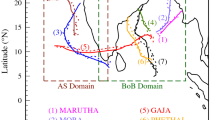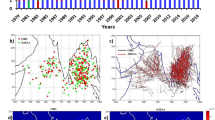Abstract
An attempt has been made in this study to evaluate the performance of a multi-model ensemble prediction system (MMEPS) in the extended range prediction of genesis and track of cyclonic storms (CS) over North Indian Ocean (NIO) during the onset phase of Indian summer monsoon. The MMEPS comprises of National Centres for Environmental Prediction Climate Forecast System version 2 and its atmospheric component, Global Forecast System version 2, at two different resolutions. In this study, we analyse the performance of this MMEPS in the prediction of six CS cases formed around the onset phase of the Indian summer monsoon over NIO. Along with this, we evaluate the usefulness of the genesis potential parameter used by India Meteorological Department (IMD) for the real-time cyclogenesis prediction. ERA-Interim re-analysis data sets are used to compare MME predictions from two initial conditions (IC) close to the genesis date of each storm. Results show that genesis forecasts from nearest available IC is capturing the vorticity and associated features of the storm better than far-IC. A modified version of vortex tracking scheme developed by Geophysical Fluid Dynamics Laboratory is used to obtain the mean track positions from MME outputs and compare with IMD-best tracks. Track verification is done by calculating average direct position error, cross-track error and along-track error against corresponding IMD-best tracks. It is found that track predictions from both near and far ICs have lower average errors initially with near-IC having lesser errors as compared to far-IC. Along-track error for pre-genesis track prediction from far-IC implies that the predicted tracks remarkably lag behind observed tracks for most of the cases. These errors could be contributed from the inability of the models in realistically capturing the region of evolution and intensification of both thermodynamic and dynamic parameters with increasing lead time.










Similar content being viewed by others
References
Abhilash S et al. (2012) Performance of an ensemble prediction system based on CFSV2 for the extended range prediction of active-break spells of Indian summer monsoon rainfall during 2011. IITM Res Rep RR-128
Abhilash S, Sahai AK, Pattnaik S, De S (2013) Predictability during active break phases of Indian summer monsoon in an ensemble prediction system using climate forecast system. J Atmos Solar Terr Phys 100:13–23. https://doi.org/10.1016/j.jastp.2013.03.017
Abhilash S, Sahai AK, Borah N, Chattopadhyay R, Joseph S, Sharmila S, De S, Goswami BN (2014a) Does bias correction in the forecasted SST improve the extended range prediction skill of active-break spells of Indian summer monsoon rainfall? Atmos Res Lett 15(2):114–119. https://doi.org/10.1002/asl2.477
Abhilash S, Sahai AK, Pattnaik S, Goswami BN, Kumar A (2014b) Extended range prediction of active-break spells of Indian summer monsoon rainfall using an ensemble prediction system in NCEP Climate Forecast System. Int J Climatol 34(1):98–113. https://doi.org/10.1002/joc.3668
Abhilash S, Sahai AK, Borah N, Joseph S, Chattopadhyay R, Sharmila S, Rajeevan M, Mapes BE, Kumar A (2015) Improved spread-error relationship and probabilistic prediction from the CFS-based grand ensemble prediction system. J Appl Meteorol Climatol 54(7):1569–1578. https://doi.org/10.1175/JAMC-D-14-0200.1
Belanger JI, Webster PJ, Curry JA, Jelinek MT (2012) Extended prediction of North Indian Ocean tropical cyclones. Weather Forecast 27(3):757–769. https://doi.org/10.1175/WAF-D-11-00083.1
Berrisford P, Dee D, Poli P, Brugge R, Fielding K, Fuentes M, Kallberg P, Kobayashi S, Uppala S, Simmons A (2011) The ERA-Interim archive Version 2.0, ERA report series 1. Technical report 25073. ECMWF, Shinfield Park, Reading, UK, pp 23
Borah N, Abhilash S, Joseph S, Chattopadhyay R, Sharmila S, Sahai AK (2013) Development of extended range prediction system using CFSv2 and its verification. IITM Research Rep. RR-130
Camargo SJ, Emanuel KA, Sobel AH (2007) Use of a Genesis Potential Index to diagnose ENSO effects on tropical cyclone genesis. J Clim 20:4819–4834. https://doi.org/10.1175/JCLI4282.1
DeMaria M, Knaff JA, Bernadette HC (2001) A tropical cyclone genesis parameter for the tropical Atlantic. Weather Forecast 16:219–233. https://doi.org/10.1175/1520-0434(2001)016%3c0219:ATCGPF%3e2.0.CO;2
Dupont T, Plu M, Caroff P, Faure G (2011) Verification of ensemble-based uncertainty circles around tropical cyclone track forecasts. Weather Forecast 26(5):664–676. https://doi.org/10.1175/WAF-D-11-00007.1
ECMWF archive catalogue: ERA Interim daily averaged data sets (2016). http://apps.ecmwf.int/datasets/data/interim-full-daily/levtype=pl/. Accessed 20 Oct 2016
Ek M, Mitchell K, Lin Y, Rogers E, Grunmann P, Koren V, Gayno G, Tarpley J (2003) Implementation of Noah land surface model advances in the National centers for environmental prediction operational mesoscale Eta model. J Geophys Res 108(D22):8851. https://doi.org/10.1029/2002JD003296
Elsberry RL, Jordan MS, Vitart F (2010) Predictability of tropical cyclone events on intraseasonal timescales with the ECMWF monthly forecast model. Asia-Pac J Atmos Sci 46(2):135–153. https://doi.org/10.1007/s13143-010-0013-4
Elsberry RL, Jordan MS, Vitart F (2011) Evaluation of the ECMWF 32-day ensemble predictions during 2009 season of western North Pacific tropical cyclone events on intraseasonal timescales. Asia-Pac J Atmos Sci 47(4):305–318. https://doi.org/10.1007/s13143-011-0017-8
Elsberry RL, Tsai HC, Jordan MS (2014) Extended-range forecasts of atlantic tropical cyclone events during 2012 using the ECMWF 32-day ensemble predictions. Weather Forecast 29(2):271–288. https://doi.org/10.1175/WAF-D-13-00104.1
Emanuel KA, Nolan DS (2004) Tropical cyclone activity and the global climate system. In: 26th Conference on hurricanes and tropical meteorology, Miami, FL, vol 10. American Meteorological Society (preprints)
Evan AT, Camargo SJ (2011) A climatology of Arabian Sea cyclonic storms. J Clim 24(1):140–158. https://doi.org/10.1175/2010JCLI3611.1
Gray WM (1968) Global view of the origin of tropical disturbances and storms. Mon Weather Rev 96(10):669–700. https://doi.org/10.1175/1520-0493(1968)096%3c0669:GVOTOO%3e2.0.CO;2
Gray WM (1977) Tropical cyclone genesis in the western North Pacific. Department of Atmospheric Science, Colorado State University, Fort Collins. https://doi.org/10.2151/jmsj1965.55.5_465
Gray WM (1979) Hurricanes: their formation, structure and likely role in the tropical circulation. Meteorology over the tropical oceans. R Meteorol Soc 77:155–218
Griffies SM, Harrison MJ, Pacanowski RC, Rosati A (2004) A technical guide to MOM4. GFDL, Ocean Group technical report no. 5, Princeton, NJ. NOAA/GFDL, p 342
Heming JT (2017) Tropical cyclone tracking and verification techniques for Met Office numerical weather prediction models. Meteorol Appl 24(1):1–8. https://doi.org/10.1002/met.1599
Houtekamer PL et al (1996) A system simulation approach to ensemble prediction. Mon Weather Rev 124(6):1225–1242. https://doi.org/10.1175/1520-0493(1996)124%3c1225:ASSATE%3e2.0.CO;2
India Meteorological Department (2010) Annual cyclone review. http://www.rsmcnewdelhi.imd.gov.in/images/pdf/publications/annual-cyclone-review/annual-review-2010.pdf. Accessed 26 Oct 2016
India Meteorological Department (2013) Cyclone warning in India: standard operation procedure. Ministry of Earth Sciences, Government of India, New Delhi, SOP No. 10/2013, 200, p 1
India Meteorological Department (2014a) Annual cyclone review. http://www.rsmcnewdelhi.imd.gov.in/images/pdf/publications/annual-cyclone-review/Annual%20Review-2014.pdf. Accessed 26 Oct 2016
India Meteorological Department (2014b) RSMC Bulletins for cyclones. http://www.rsmcnewdelhi.imd.gov.in/images/pdf/archive/bulletins/2015/RAS.pdf. Accessed 26 Oct 2016
India Meteorological Department (2015) RSMC Bulletins for cyclones. http://www.rsmcnewdelhi.imd.gov.in/images/pdf/archive/bulletins/2016/RROA.pdf
India Meteorological Department (2016) RSMC Bulletins for cyclones. http://www.rsmcnewdelhi.imd.gov.in/images/pdf/archive/bulletins/2013/RNA.pdf. Accessed 26 Oct 2016
India Meteorological Department (2017) Best track data archive. http://www.rsmcnewdelhi.imd.gov.in/images/pdf/archive/best-track/best%20track%20ecscsuc-2017.xls. Accessed 9 Apr 2017
Jaiswal N, Kishtawal CM, Bhomia S, Pal PK (2016) Multi-model ensemble-based probabilistic prediction of tropical cyclogenesis using TIGGE model forecasts. Meteorol Atmos Phys. https://doi.org/10.1007/s00703-016-0436-2
Joseph S, Sahai AK, Sharmila S, Abhilash S, Borah N, Chattopadhyay R, Pillai PA, Rajeevan M, Kumar A (2015) North Indian heavy rainfall event during June 2013: diagnostics and extended range prediction. Clim Dyn 44(7–8):2049–2065. https://doi.org/10.1007/s00382-014-2291-5
Kotal SD, Bhattacharya SK (2013) Tropical cyclone genesis potential parameter and its application over the North Indian Sea. Mausam 64(1):149–170
Kotal SD, Kundu PK, Roy Bhowmik SK (2009) Analysis of cyclogenesis parameter for developing and nondeveloping low-pressure systems over the Indian Sea. Nat Hazards 50(2):389–402. https://doi.org/10.1007/s11069-009-9348-5
Majumdar SJ, Finocchio PM (2010) On the ability of global ensemble prediction systems to predict tropical cyclone track probabilities. Weather Forecast 25(2):659–680. https://doi.org/10.1175/2009WAF2222327.1
Marchok TP (2002) How the NCEP tropical cyclone tracker works. In: AMS 25th conference on Hurricanes and tropical meteorology, San Diego, CA, pp 21–22 (preprints)
Marchok TP, Toth Z, Liu Q (2002) Use of the NCEP global ensemble for tropical cyclone track forecasting. In: 25th Conference on Hurricanes and tropical meteorology, San Diego, CA. American Meteorological Society, pp 176–177 (preprints)
McBride JL, Zehr RM (1981) Observational analysis of tropical cyclone formation. Part II: comparison of non-developing versus developing systems. J Atmos Sci 38:1132–1151. https://doi.org/10.1175/1520-0469(1981)038%3c1132:OAOTCF%3e2.0.CO;2
Nath S, Kotal SD, Kundu PK (2013) Analysis of a genesis potential parameter during pre-cyclone watch period over the Bay of Bengal. Nat Hazards 65(3):2253–2265. https://doi.org/10.1007/s11069-012-0473-1
Pattanaik DR et al (2013) A preliminary study about the prospects of extended range forecast of tropical cyclogenesis over the North Indian Ocean during 2010 post-monsoon season. Mausam 64(1):171–188
Pattanaik DR, Mohapatra M (2014) Multi-model ensemble based extended range forecast of tropical cyclogenesis over the North Indian Ocean. In: Mohanty UC et al (eds) Monitoring and prediction of tropical cyclones in the Indian Ocean and climate change, 1st edn. Springer, Netherlands, pp 203–216
Saha S et al (2014) The NCEP climate forecast system version 2. J Clim 27:2185–2208. https://doi.org/10.1175/JCLI-D-12-00823.1
Sahai AK et al (2013) Simulation and extended range prediction of monsoon intraseasonal oscillations in NCEP CFS/GFS version 2 framework. Curr Sci 104(10):1394–1408
Sahai AK et al (2016) MJO diagnostics for extended range prediction and simulation in IITM CFSv2. IITM Res Rep RR-136
Wang B, Xu S, Wu L (2012) Intensified Arabian Sea tropical storms. Nature 489(7416):E1. https://doi.org/10.1038/nature11470
Wu X, Moorthi KS, Okomoto K, Pan HL (2005) Sea ice impacts on GFS forecasts at high latitudes. In: Eighth conference on polar meteorology and oceanography, San Diego, CA. American Meteorological Society, p 7.4. http://ams.confex.com/ams/pdfpapers/84292.pdf (preprints)
Zehr RM (1992) Tropical cyclogenesis in the western North Pacific. NOAA Tech Rep NESDIS 61, p 181
Acknowledgements
Authors would like to thank Ministry of Earth Sciences, Government of India, as all the research at Indian Institute of Tropical Meteorology is fully supported by the Ministry. All the data sources are duly acknowledged. The figures and graphs were plotted using GrADS and Xmgrace. Authors would like to thank the developers, for making software packages freely available. SGS gratefully acknowledge the Department of Atmospheric and Space Sciences, Savitribai Phule Pune University for granting admission to the Ph.D. programme and Indian Institute of Tropical Meteorology for research fellowship. AS thank UGC-BSR for providing the facility to carry out the analysis.
Author information
Authors and Affiliations
Corresponding author
Rights and permissions
About this article
Cite this article
Saranya Ganesh, S., Abhilash, S., Sahai, A.K. et al. Genesis and track prediction of pre-monsoon cyclonic storms over North Indian Ocean in a multi-model ensemble framework. Nat Hazards 95, 823–843 (2019). https://doi.org/10.1007/s11069-018-3522-6
Received:
Accepted:
Published:
Issue Date:
DOI: https://doi.org/10.1007/s11069-018-3522-6




